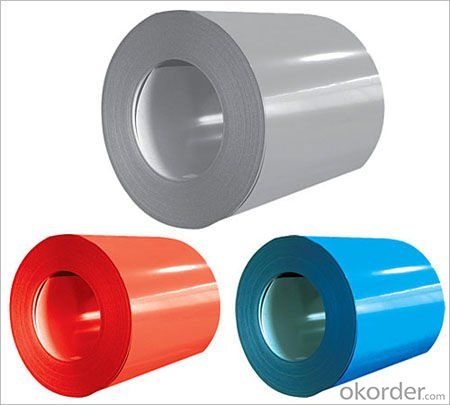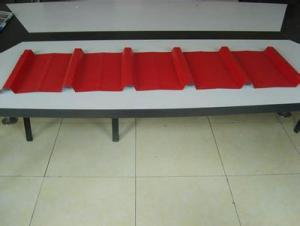Pre-Painted Galvanized Corrugated Steel in Brick Red
- Loading Port:
- Shanghai
- Payment Terms:
- TT or LC
- Min Order Qty:
- 100 m.t.
- Supply Capability:
- 10000 m.t./month
OKorder Service Pledge
OKorder Financial Service
You Might Also Like
1. Pre-Painted GI/GL Steel Coil Description:
With GI as base material, after pretreatment (degrease and chemical treatment ) and liquid dope with several layers of color, then after firing and cooling, finally the plate steel is called pre-painted galvanized (aluzinc) steel. Pre-painted galvanized steel is good capable of decoration, molding, corrosion resistance. It generally displays superior workability, durability and weather resistance.
2.Main Features of the Pre-Painted GI/GL Steel Coil:
• Excellent process capability
• Smooth and flat surface
• Workability, durability
• Excellent heat resistance performance
• High strength
• Good formability
• Good visual effect
3.Pre-Painted GI/GL Steel Coil Images

4.Pre-Painted GI/GL Steel Coil Specification
Standard: AISI, ASTM, BS, DIN, GB, JIS
Grade: DX51D, DX52D
Thickness: 0.17-2.0mm
Brand Name: KMRLON
Model Number: coil
Type: Steel Coil
Technique: Cold Rolled
Surface Treatment: Coated
Application: Boiler Plate
Special Use: High-strength Steel Plate
Width: 20-1250mm
Length: customized
commoidty: pre-painted galvanized steel coil
Thickness: 0.13-4.0mm
width: 20-1250mm
zinc coating: 40-180g/m2
printing thickness: top side: 20+/-5 microns, back side: 5-7 microns
color: all RAL color
surface treatment: color coated
coil weight: 4-7 tons
coil ID: 508/610mm
packaging: standard seaworthy packing
5.FAQ of Pre-Painted GI/GL Steel Coil
1. What’s the application of this product?
Roof, roof structure, surface sheet of balcony, frame of window, etc.
2. What’s the brand of the paint?
We use the best brand of all of the word—AKZO.
3. How to guarantee the quality of the products?
We have established the international advanced quality management system,every link from raw material to final product we have strict quality test;We resolutely put an end to unqualified products flowing into the market. At the same time, we will provide necessary follow-up service assurance.
4. How long can we receive the product after purchase?
Usually within thirty working days after receiving buyer’s advance payment or LC. We will arrange the factory manufacturing as soon as possible. The cargo readiness usually takes 15-25 days, but the shipment will depend on the vessel situation.
- Q:How is the quality of steel sheets determined?
- The quality of steel sheets is determined by several factors and tests. One of the primary factors is the chemical composition of the steel, which includes the presence and percentage of various elements such as carbon, manganese, silicon, and alloying elements like chromium, nickel, and molybdenum. The specific composition affects the steel's strength, durability, and resistance to corrosion. Another important aspect is the mechanical properties of the steel, which are assessed through tests such as tensile strength, yield strength, elongation, hardness, and impact resistance. These tests help determine the steel's ability to withstand applied forces and deformation without failure. Surface quality is also crucial in determining the quality of steel sheets. The surface should be free from defects like cracks, scratches, pits, or any other irregularities that could affect the performance or appearance of the steel. Furthermore, the thickness and uniformity of the steel sheets are crucial factors. Thickness is measured using methods like ultrasonic gauges or micrometers to ensure compliance with the required specifications. Any deviations from the specified thickness can affect the structural integrity and performance of the steel sheets. Additionally, the steel sheets undergo various tests to assess their weldability, formability, and machinability, which determine their suitability for specific applications. These tests help evaluate the steel's behavior during fabrication processes like welding, bending, or machining. Overall, the quality of steel sheets is determined by a comprehensive evaluation of their chemical composition, mechanical properties, surface quality, thickness, and other specific performance characteristics. These assessments ensure that the steel sheets meet the required standards and are suitable for the intended applications.
- Q:Are steel sheets suitable for playground equipment?
- Yes, steel sheets can be suitable for playground equipment. Steel is a durable and strong material that can withstand heavy use and various weather conditions. It can be used to create structures like climbing frames, slides, and swings, ensuring the safety and longevity of the playground equipment.
- Q:Can steel sheets be used in packaging applications?
- Yes, steel sheets can be used in packaging applications. They are often used for packaging heavy and durable items, providing strength, durability, and protection during transportation and storage.
- Q:Can steel sheets be used for safety barriers or guardrails?
- Yes, steel sheets can be used for safety barriers or guardrails. Steel sheets are commonly used in construction and infrastructure projects due to their strength and durability. They are often used to create robust safety barriers and guardrails that provide protection and prevent accidents in various settings such as highways, bridges, and industrial facilities.
- Q:Can steel sheets be used for electrical grounding purposes?
- No, steel sheets are not suitable for electrical grounding purposes as they are not good conductors of electricity.
- Q:Are steel sheets suitable for elevator shafts or cabin interiors?
- Steel sheets are suitable for both elevator shafts and cabin interiors. They are widely used in the construction industry because of their strength, durability, and versatility. Elevator shafts commonly utilize steel sheets due to their ability to withstand heavy loads and provide structural support. Additionally, they offer excellent fire resistance and can endure extreme temperatures, ensuring a safe environment. Regarding cabin interiors, steel sheets provide numerous advantages. They can be easily shaped and sized to allow for customization and design flexibility. Moreover, steel sheets can be painted or coated, resulting in a smooth and visually appealing finish. They are highly resistant to wear and tear, guaranteeing long-lasting durability in high-traffic areas such as elevator cabins. Furthermore, steel sheets possess soundproofing properties, which are essential for creating a comfortable and quiet experience for passengers in elevator cabins. Additionally, they resist moisture and corrosion, making them suitable for elevator cabins located in humid or coastal regions. In conclusion, steel sheets are an exceptional choice for elevator shafts and cabin interiors due to their strength, durability, versatility, fire resistance, soundproofing capabilities, and resistance to moisture and corrosion.
- Q:What is the maximum load-bearing capacity of steel sheets?
- The specific type and thickness of steel sheets can cause the maximum load-bearing capacity to vary. Steel sheets are generally known for their strength and durability, which allows them to handle heavy loads. The load-bearing capacity of steel sheets is typically measured by its yield strength or ultimate tensile strength. Yield strength refers to the maximum stress a steel sheet can handle before permanently deforming, while ultimate tensile strength refers to the maximum stress it can handle before fracturing. The load-bearing capacity of steel sheets can range from a few hundred pounds to several thousand pounds per square inch (psi). For instance, mild steel sheets usually have a yield strength of approximately 50,000 psi, enabling them to support moderate loads. Conversely, high-strength steel sheets can have a yield strength of over 100,000 psi, allowing them to withstand heavy loads. It's important to consider that the load-bearing capacity of steel sheets can also be affected by factors such as dimensions, surface condition, and support method. Moreover, engineers and structural designers often take safety margins and the factor of safety into account when determining the maximum load-bearing capacity of steel sheets for specific applications. Therefore, it is advisable to consult relevant engineering standards, specifications, or professionals for accurate load-bearing capacity information in a particular context.
- Q:Are steel sheets suitable for architectural cladding?
- Yes, steel sheets are suitable for architectural cladding. Steel is a durable and versatile material that offers a range of benefits for cladding applications. Its strength and rigidity make it capable of withstanding harsh weather conditions, including strong winds, heavy rain, and snow. This durability ensures that the cladding will last for many years without requiring frequent maintenance or replacement. In addition to its durability, steel sheets provide a sleek and modern aesthetic to buildings. They can be finished in various ways, including painting, powder coating, or applying a metallic finish, allowing for endless design possibilities. Steel cladding can be used to achieve a contemporary or industrial look, making it a popular choice for commercial and residential buildings alike. Steel sheets are also highly resistant to fire, pests, and rot, making them a safe and long-lasting choice for cladding. They are also relatively lightweight, which can help reduce construction costs and make installation easier. Furthermore, steel is an environmentally friendly material. It is recyclable, making it a sustainable choice for cladding. Steel cladding can also help improve energy efficiency by providing better insulation and reducing heat transfer, resulting in lower energy consumption for heating and cooling. Overall, steel sheets are a suitable option for architectural cladding due to their durability, aesthetic appeal, safety features, sustainability, and energy efficiency benefits.
- Q:What is the average moisture resistance of steel sheets?
- The average moisture resistance of steel sheets can vary depending on the specific type of steel and the protective coatings applied. Generally, steel sheets exhibit good moisture resistance due to their inherent ability to resist corrosion. However, additional surface treatments like galvanization can further improve their resistance by adding a layer of zinc to protect against moisture and corrosion. Providing an exact average moisture resistance value is challenging as it depends on factors such as the steel grade, thickness, and coating. Steel sheets with galvanized coatings typically offer excellent moisture resistance, with some studies reporting corrosion rates as low as 0.1-0.5 micrometers per year in highly corrosive environments. It is important to consider that the performance of steel sheets in resisting moisture can also be affected by factors like scratches, cuts, or exposure to chemicals. Proper maintenance, regular inspection, and careful handling of steel sheets are crucial to ensure their optimal moisture resistance over time.
- Q:How do steel sheets perform in tensile strength?
- Steel sheets have excellent tensile strength, meaning they can withstand high levels of stretching or pulling forces without breaking or deforming. This is due to the strong and interconnected molecular structure of steel, making it a reliable and durable material for various applications that require resistance to tension.
1. Manufacturer Overview |
|
|---|---|
| Location | |
| Year Established | |
| Annual Output Value | |
| Main Markets | |
| Company Certifications | |
2. Manufacturer Certificates |
|
|---|---|
| a) Certification Name | |
| Range | |
| Reference | |
| Validity Period | |
3. Manufacturer Capability |
|
|---|---|
| a)Trade Capacity | |
| Nearest Port | |
| Export Percentage | |
| No.of Employees in Trade Department | |
| Language Spoken: | |
| b)Factory Information | |
| Factory Size: | |
| No. of Production Lines | |
| Contract Manufacturing | |
| Product Price Range | |
Send your message to us
Pre-Painted Galvanized Corrugated Steel in Brick Red
- Loading Port:
- Shanghai
- Payment Terms:
- TT or LC
- Min Order Qty:
- 100 m.t.
- Supply Capability:
- 10000 m.t./month
OKorder Service Pledge
OKorder Financial Service
Similar products
New products
Hot products
Related keywords





























